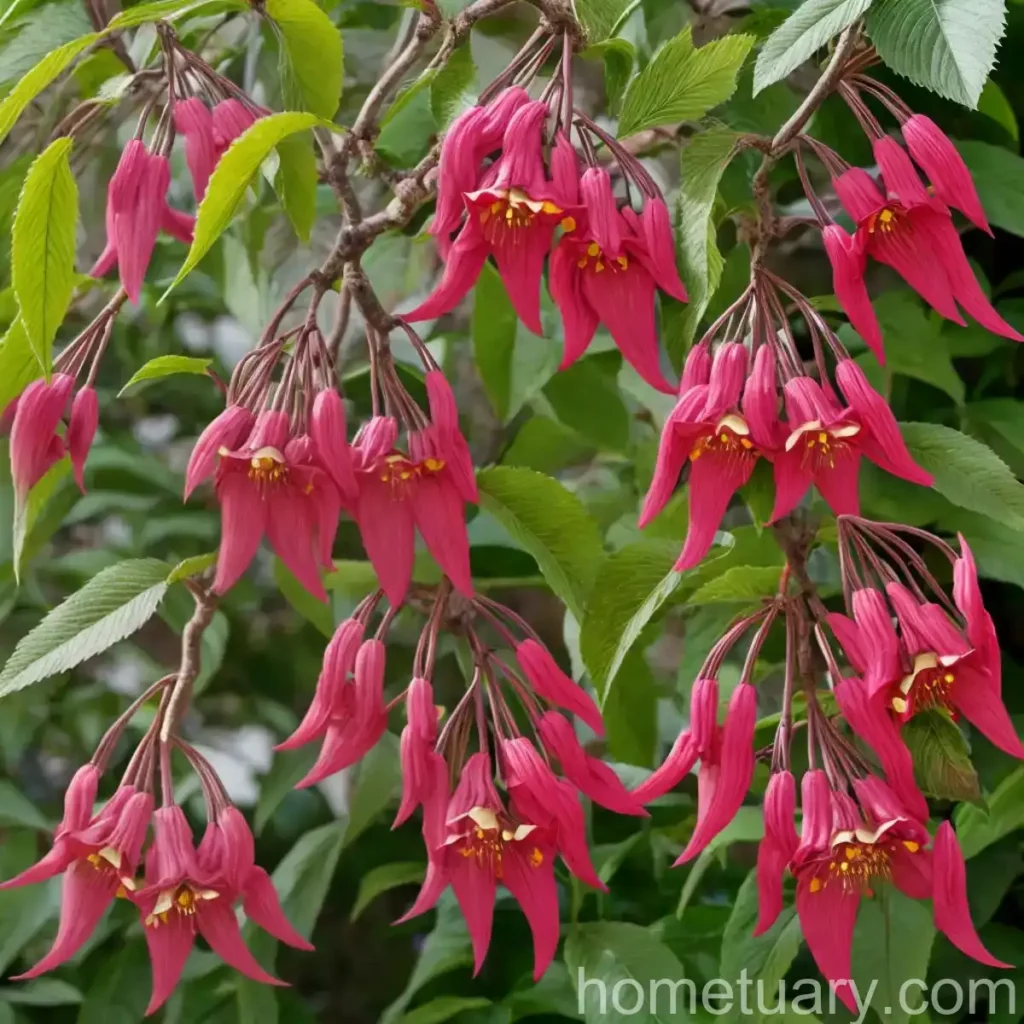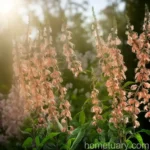Cape Fuchsia (Phygelius ‘Blacher’ CHERRY RIPE): A Complete Plant Guide
Cape fuchsia, scientifically known as Phygelius ‘Blacher’ CHERRY RIPE, is a much-admired plant due to its bright, tubular flowers and ornamental foliage. This plant is increasingly becoming a favorite in gardens for its ability to attract wildlife and add vibrant color to the landscape. In this comprehensive guide, we will delve into the information, care, cultivation, and maintenance of Cape fuchsia, providing insights into its characteristics, uses, and essential tips for ensuring its health and vitality.
Cape Fuchsia Information
Cape fuchsia, or Phygelius ‘Blacher’ CHERRY RIPE, is a flowering perennial native to South Africa. Belonging to the family Scrophulariaceae, this species is characterized by its striking tubular flowers that resemble those of fuchsias, hence its common name. The plant’s botanical name, Phygelius, is derived from the Greek word “phyge,” which means “flee,” referencing the way the anthers recede when touched. ‘Blacher’ CHERRY RIPE is a specific cultivar known for its deep red tubular flowers.
Key Takeaways
Let’s explore some key takeaways about Cape fuchsia:
Characteristics
- Flowers: Tubular, bright red, resembling fuchsias
- Foliage: Dark green, lance-shaped leaves
- Growth Habit: Upright and bushy, reaching heights of 2-4 feet
- Wildlife Attraction: Attracts bees, butterflies, and hummingbirds
Cultivation
- Sunlight: Partial to full sun
- Soil: Well-draining, rich in organic matter
- Water: Moderate, avoiding waterlogged conditions
- Hardiness: Suitable for USDA hardiness zones 7-10
Maintenance
- Pruning: Deadheading spent flowers and light pruning in late winter or early spring
- Propagation: Easily propagated by division or softwood cuttings
- Diseases: Susceptible to powdery mildew and root rot
- Pests: Occasionally affected by aphids and spider mites
Now, let’s delve deeper into each of these aspects to gain a comprehensive understanding of Cape fuchsia and its care requirements.
Cultivation
Uses
Cape fuchsia is a versatile plant that can be effectively utilized in various landscape and garden settings. Some common uses include:
- Border Plant: Its vibrant flowers make it an attractive choice for border plantings
- Wildlife Gardens: Its ability to attract pollinators makes it an excellent addition to wildlife-friendly gardens
- Containers: Well-suited for container gardening, adding color and interest to patio areas
- Cut Flowers: The flowers can be used in floral arrangements due to their unique shape and color
Water
Proper watering is crucial to the health and vitality of Cape fuchsia. Here are some essential tips for watering this plant:
- Frequency: Water deeply and infrequently, allowing the soil to dry out slightly between waterings
- Avoid Waterlogging: Ensure that the soil is well-draining to prevent waterlogging, which can lead to root rot
- Drought Tolerance: Once established, Cape fuchsia exhibits good drought tolerance, reducing the need for frequent watering
Sunlight
Cape fuchsia thrives in locations with ample sunlight, but it can also tolerate partial shade. Consider the following sunlight requirements for optimal growth:
- Full Sun: Ideally, position the plant in a location that receives at least 6-8 hours of direct sunlight daily for abundant flowering
- Partial Shade: In hot climates, providing some afternoon shade can help protect the plant from excessive heat and sun exposure
Fertilizer
Proper fertilization can enhance the growth and blooming of Cape fuchsia. Consider the following guidelines for fertilizing this plant:
- Timing: Apply a balanced, all-purpose fertilizer in early spring as new growth begins
- Frequency: Reapply fertilizer every 6-8 weeks during the growing season to support continuous blooming
- Avoid Overfertilization: Excessive fertilization can lead to leggy growth and reduced flowering, so follow the recommended dosage guidelines
Soil
The type of soil in which Cape fuchsia is planted significantly influences its growth and overall health. Here’s what you need to know about soil requirements for this plant:
- Well-Draining: Plant Cape fuchsia in well-draining soil to prevent waterlogging and root rot
- Organic Matter: Amending the soil with organic matter, such as compost, can improve its fertility and drainage
- pH Level: Cape fuchsia prefers slightly acidic to neutral soil with a pH range of 6.0-7.0
Pruning
Proper pruning is essential for maintaining the attractive appearance of Cape fuchsia and promoting continued blooming. Follow these tips for effective pruning:
- Deadheading: Remove spent flowers regularly to encourage the production of new blooms
- Winter Pruning: In late winter or early spring, lightly prune the plant to remove any dead or damaged stems and encourage new growth
- Shape Maintenance: Prune to shape the plant and maintain a tidy appearance, especially after the blooming season
Propagation
Cape fuchsia is relatively easy to propagate through division or cuttings. Here’s how you can propagate this plant:
Division
- Timing: Divide established plants in early spring before new growth emerges
- Process: Carefully dig up the plant and use a sharp, clean knife to divide the root ball into sections, ensuring that each division has several healthy shoots and a viable root system
- Replanting: Plant the divisions in prepared soil and water thoroughly to promote establishment
Cuttings
- Timing: Take softwood cuttings in late spring or early summer
- Preparation: Select healthy, non-flowering shoots and cut them into 4-6 inch sections
- Planting: Dip the cut end in rooting hormone and plant the cuttings in a well-draining potting mix. Keep the soil consistently moist and provide gentle bottom heat to encourage rooting
Container Popularity
Cape fuchsia is well-suited for container gardening, offering beautiful blooms and attractive foliage in a potted environment. Consider these factors when growing Cape fuchsia in containers:
- Container Size: Use a container with sufficient depth and width to accommodate the plant’s root system and provide stability
- Drainage: Ensure that the container has drainage holes to prevent waterlogging
- Potting Mix: Use a well-draining potting mix enriched with organic matter for optimal growth
Common Diseases
While Cape fuchsia is generally resistant to many diseases, it can be susceptible to certain issues that may impact its health and appearance. Common diseases include:
Disease Diagnosis
- Powdery Mildew: Identified by the presence of a white, powdery coating on the leaves and stems
- Root Rot: Symptoms include wilting, yellowing leaves, and a foul odor from the roots when the plant is affected by root rot
Disease Prevention
- Proper Air Circulation: Ensure adequate spacing between plants to promote air circulation and reduce the risk of powdery mildew
- Well-Draining Soil: Plant Cape fuchsia in well-draining soil to prevent waterlogging and minimize the risk of root rot
Common Pests
Cape fuchsia is relatively resistant to pest infestations, but it may occasionally encounter issues with certain pests. The following pests are commonly associated with this plant:
- Aphids: These small, sap-sucking insects can be found clustered on the leaves and stems, leading to distorted growth and honeydew secretion
- Spider Mites: These pests can cause stippling and discoloration on the leaves, particularly in hot and dry conditions
Pest Control
- Natural Predators: Encourage the presence of natural predators, such as ladybugs and lacewings, to help control aphid infestations
- Hose Down: Use a strong stream of water to dislodge and remove spider mites from the plant, particularly the undersides of the leaves
Botanist’s Tips
As a botanist specializing in ornamental plants, here are some additional tips and insights that can help you successfully grow and care for Cape fuchsia:
- Companion Plants: Pair Cape fuchsia with complementary plants such as Salvia, Echinacea, and Agastache to create a visually appealing and wildlife-friendly garden
- Mulching: Apply a layer of organic mulch around the base of Cape fuchsia to help retain moisture, suppress weeds, and maintain a consistent soil temperature
- Wildlife Garden: Create a wildlife-friendly garden by incorporating a variety of nectar-rich plants to attract and support pollinators, which can enhance the overall health of your garden ecosystem
- Winter Protection: In colder climates, provide a layer of mulch around the base of the plant to insulate the roots and protect them from freezing temperatures
Fun Facts
- The tubular flowers of Cape fuchsia are especially attractive to hummingbirds, making it a valuable addition to gardens designed to attract these fascinating birds.
- Cape fuchsia is also known by the common names “Cape figwort” and “Cape poker.”
Links to External Resources
To further enhance your knowledge and understanding of Cape fuchsia, consider exploring the following reputable external resources:
- Royal Horticultural Society – Growing Phygelius
- University of California Agriculture & Natural Resources – Pest Notes: Aphids
- North Carolina State University Extension – Spider Mites in the Garden
- Missouri Botanical Garden – Powdery Mildew on Ornamentals
In conclusion, Cape fuchsia, or Phygelius ‘Blacher’ CHERRY RIPE, is a captivating plant that combines striking flowers with wildlife appeal, making it an excellent choice for gardeners seeking to create vibrant and ecologically rich landscapes. By following the guidelines and tips provided in this comprehensive plant guide, you can successfully cultivate and care for Cape fuchsia, enhancing the beauty and biodiversity of your outdoor spaces.
Remember, as with any plant, it’s essential to observe your Cape fuchsia regularly and adjust care practices as needed to ensure its continued health and vitality.
Keywords: Cape fuchsia information, Phygelius ‘Blacher’ CHERRY RIPE care, growing Cape fuchsia, Cape fuchsia varieties, Phygelius ‘Blacher’ CHERRY RIPE characteristics, Cape fuchsia plant guide, Phygelius ‘Blacher’ CHERRY RIPE tips, how to grow Phygelius ‘Blacher’ CHERRY RIPE, Cape fuchsia planting, Phygelius ‘Blacher’ CHERRY RIPE maintenance, Cape fuchsia care instructions, Phygelius ‘Blacher’ CHERRY RIPE features, Cape fuchsia watering, Phygelius ‘Blacher’ CHERRY RIPE pruning, Cape fuchsia propagation, Phygelius ‘Blacher’ CHERRY RIPE diseases, Cape fuchsia pests, Phygelius ‘Blacher’ CHERRY RIPE sunlight requirements, Cape fuchsia soil conditions, Phygelius ‘Blacher’ CHERRY RIPE flowering, Cape fuchsia season, Phygelius ‘Blacher’ CHERRY RIPE hardiness, Cape fuchsia landscape uses, Phygelius ‘Blacher’ CHERRY RIPE container gardening, Cape fuchsia companion plants, Phygelius ‘Blacher’ CHERRY RIPE pollinators, Cape fuchsia wildlife attraction, Phygelius ‘Blacher’ CHERRY RIPE garden design, Cape fuchsia decorative element, Phygelius ‘Blacher’ CHERRY RIPE color variations, Cape fuchsia pruning techniques, Phygelius ‘Blacher’ CHERRY RIPE winter protection, Cape fuchsia climate preferences, Phygelius ‘Blacher’ CHERRY RIPE flowering period, Cape fuchsia native habitat, Phygelius ‘Blacher’ CHERRY RIPE growth habit, Cape fuchsia water requirements, Phygelius ‘Blacher’ CHERRY RIPE fertilizing tips, Cape fuchsia plant health, Phygelius ‘Blacher’ CHERRY RIPE disease prevention, Cape fuchsia gardening tips, Phygelius ‘Blacher’ CHERRY RIPE landscape ideas, Cape fuchsia drought tolerance, Phygelius ‘Blacher’ CHERRY RIPE pest control, Cape fuchsia outdoor cultivation, Phygelius ‘Blacher’ CHERRY RIPE propagation methods, Cape fuchsia common issues, Phygelius ‘Blacher’ CHERRY RIPE wildlife garden, Cape fuchsia sun exposure, Phygelius ‘Blacher’ CHERRY RIPE flowering characteristics















